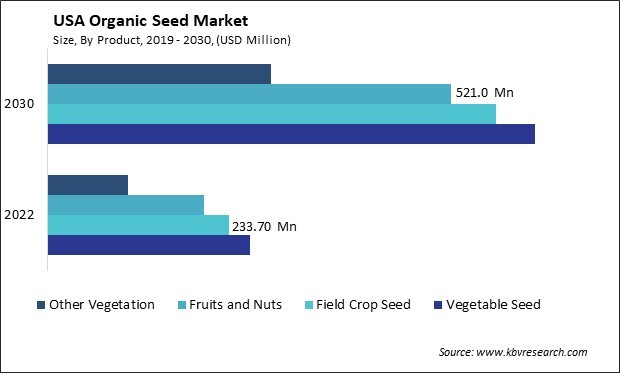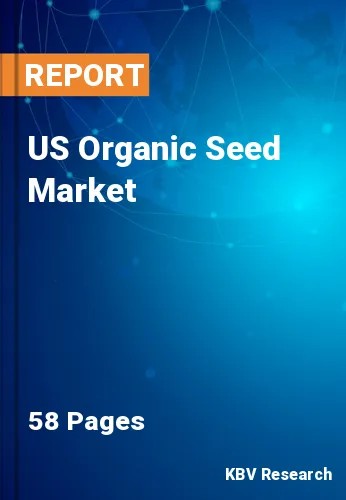The USA Organic Seed Market size is expected to reach $2 billion by 2030, rising at a market growth of 12.4% CAGR during the forecast period. In the year 2022, the market attained a volume of 123.5 million units, experiencing a growth of 12.2% (2019-2022).
The organic acids market in the United States has witnessed significant growth in recent years, driven by factors such as increasing consumer awareness about healthy and sustainable lifestyles, the demand for organic and clean-label products, and the expanding food and beverage industry. The U.S. organic acids market has experienced a notable surge in demand due to consumers' rising popularity of organic and natural products. With a growing emphasis on environmentally friendly and sustainable practices, many industries are incorporating organic acids. Moreover, the pharmaceutical and animal feed industries also contribute to the expanding use of organic acids, further boosting industry growth.

In recent years, there has been a notable surge in research and development activities to explore novel industrial applications of organic acids. This has led to the discovery of innovative uses, further propelling the industry growth. The U.S. regulatory environment, known for its stringent standards, has played a crucial role in ensuring the safety and compliance of organic acids applications in various industries.
The COVID-19 pandemic has had a mixed impact on the organic acids market in the U.S. While the food and beverage sector faced disruptions in the supply chain and a shift in consumer preferences, the demand for organic acids in pharmaceuticals and healthcare products witnessed a notable increase. Organic acids produce certain pharmaceuticals and sanitization products, contributing to their heightened demand during the pandemic.
The organic acids market in the United States has witnessed significant expansion in recent years, particularly in industrial applications. Organic acids, including acetic acid, citric acid, and lactic acid, play a pivotal role in various industries, ranging from food and beverages to pharmaceuticals and chemicals. The pharmaceutical industry in the U.S. has also embraced organic acids for their diverse applications. Organic acids are crucial in synthesizing pharmaceutical intermediates and active pharmaceutical ingredients (APIs). Their role in drug formulation and stability has led to an increased adoption in pharmaceutical manufacturing processes. According to the Congressional Budget Office, in 2019, the pharmaceutical sector allocated a substantial $83 billion towards research and development (R&D) expenditures.
Furthermore, the chemical industry in the United States has integrated organic acids into various processes, such as polymer production and catalysts in chemical reactions. The versatility of organic acids in chemical applications has driven their demand as environmentally friendly alternatives, aligning with the industry's focus on green and sustainable practices.
According to the Cybersecurity & Infrastructure Security Agency, the U.S. chemical industry is a $486 billion enterprise that supports more than more than 25% of total U.S. GDP. The U.S. chemical industry is the world’s second largest chemical producer 13% of the world’s chemicals come from the United States. The U.S. chemical industry supports the production of almost all commercial and household goods and is essential to economic growth. Thus, the expanding organic acids market in the United States, particularly in pharmaceutical and chemical industries, reflects a strategic shift towards sustainable practices.
In recent years, the United States has witnessed a notable surge in the awareness of healthy lifestyles, particularly in organic acids market. Consumers are becoming increasingly conscious of the impact of their dietary choices on overall well-being, leading to a growing demand for products that align with healthier living. The organic acids market in the U.S. has responded to this heightened awareness by offering a diverse range of products catering to health-conscious consumers. From organic acid-infused beverages to snacks and condiments, the industry has seen many options that align with the principles of a healthy lifestyle. Manufacturers and producers increasingly emphasize using organic acids in their formulations, capitalizing on the trend toward cleaner and more natural ingredients.
One significant factor driving this trend is the escalating awareness of the potential health benefits of organic acids. As more individuals prioritize wellness, they are actively seeking products that meet their dietary preferences and contribute positively to their health. Organic acids, derived from natural sources, have gained popularity as they are perceived to be a healthier alternative to synthetic additives and preservatives.
The trend towards healthier living is not limited to food choices; it extends to lifestyle practices such as fitness routines and overall wellness. Consumers are incorporating organic acid-rich foods into their diets as part of a holistic approach to well-being. This shift in consumer behavior is reshaping the landscape of the organic acids market, prompting innovation and product development that prioritizes health and nutrition. Thus, the United States is experiencing a growing awareness of healthy lifestyles, significantly influencing the organic acids market.
The organic acids market in the United States has witnessed significant growth in recent years, driven by various factors such as increasing consumer awareness about health and wellness, rising demand for organic and natural products, and the growing importance of sustainable and eco-friendly practices. One prominent player in the U.S. organic acids market is Cargill, a multinational corporation that operates in the food, agriculture, financial, and industrial sectors. Cargill is known for its involvement in producing organic acids, particularly lactic acid and citric acid. These organic acids find applications in the food and beverage industry as acidulants, preservatives, and flavor enhancers.
Another major player in the U.S. organic acids market is Corbion, a company specializing in bio-based products, including organic acids. Corbion is recognized for its production of lactic acid, which is widely used in food and beverage applications, as well as in the production of biodegradable polymers and other sustainable materials.
Tate & Lyle, a global provider of ingredients and solutions for the food, beverage, and industrial markets, is also a significant player in the U.S. organic acids market. The company offers a range of organic acids, including citric acid and lactic acid, used in various food and beverage formulations to enhance flavor, preserve products, and improve texture.
DuPont is another key player in the organic acid market, offering diverse organic acid-based solutions. The company's portfolio includes products such as adipic acid, which is utilized in the production of nylon, and other organic acids with applications in various industries, including food and textiles.
Emerging players like Myriant Corporation are also making strides in the U.S. organic acids market. Myriant focuses on developing and commercializing bio-based chemicals, including succinic acid. Succinic acids has applications in various industries, including food, pharmaceuticals, and polymers, and is considered an environmentally friendly alternative to traditional petrochemical-based acids. In addition to these major players, smaller and niche companies also contribute to the diversity and competitiveness of the organic acids market. These companies often specialize in specific organic acids or cater to niche markets, providing unique solutions to meet the demands of various industries.
USA Organic Seed Market, by Product
Our team of dedicated experts can provide you with attractive expansion opportunities for your business.

